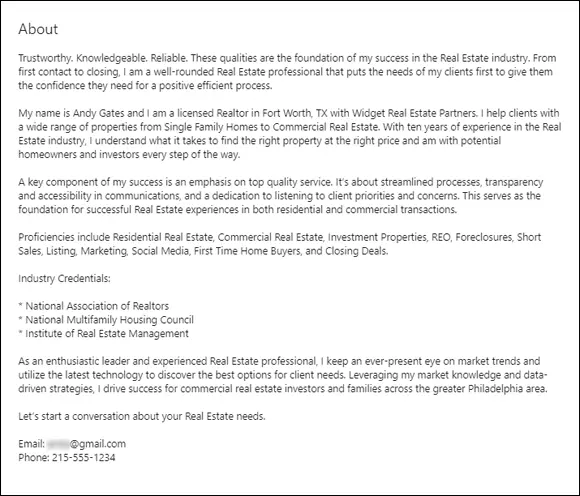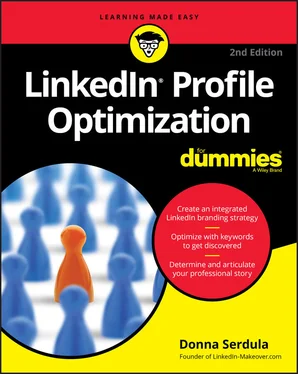LinkedIn is more than just a job search tool. LinkedIn is a compendium of professional profiles with industry and contact information, which makes it a terrific prospecting tool for sales professionals. However, it’s not just for sales people looking for prospects. People use LinkedIn to search for service providers and consultants who can help them.
Most people prefer to do business with someone they know or someone with whom they share a connection. When searching LinkedIn for a service provider, you see how you are connected to that service provider through the degrees of connection. This ability to see shared connections provides a level of trust and comfort.
A sales and prospecting profile shines the spotlight on not just the salesperson, but also on that person’s products, services, and company he or she represents. Most important, the sales and prospecting profile focuses on prospective clients and their needs, and solidifies the salesperson as someone clients can feel confident in working with. See Figure 1-2 for an example.

FIGURE 1-2:A sales and prospecting profile.
Figuring Out Your Target Audience
Knowing your goal is only half the battle. Now it’s time to figure out your target audience. One of the most common mistakes people make with their LinkedIn profiles is using it to tell the story they want to tell. Instead, you need to use your profile to tell the story your audience wants to read . Write for your target audience first.
When you are looking for a job, your target audience is typically recruiters, hiring managers, and human resources professionals. In almost every case, they are armed with a job description. Recruiters want to know that you have the skill sets and experience required to fulfill the job. They also want to know that you are professional, respectful, and capable of doing the job. You want to make it clear in your profile that you are the perfect person for your desired position. After reading your profile, the recruiter should feel confident in your skills and abilities.
When you are on LinkedIn for sales and prospecting, your target audience is your client and prospective client. They are less interested in hearing about your sales expertise and more interested in knowing that you understand their industry and their needs, and can provide solutions to their issues. As you consider your target audience, think in terms of the solutions you offer them and provide them the information they need to feel confident with you as a potential partner.
The sales world has changed in the age of Google and social media. Buyers now educate themselves, researching products and services online. They even research the salesperson, wanting to make sure they are reaching out to someone they can feel comfortable working with. Knowing that you are under a magnifying glass, make sure you provide your target audience with the information they need to feel confident in you and your products or services.
When the goal of your LinkedIn profile is reputation management and branding, your target audience may not be as clear cut as it is with a job search or sale and prospecting. To figure out your audience, you need to determine the type of person you want to cater your profile toward. Is it the executive team and colleagues at your company? Audience members who watched you give a presentation? Readers of articles you wrote? Private equity investors? Once you pinpoint the type of person who you want to target, consider what that person needs to know to take that next step forward.
Do you want your target audience to connect with you on LinkedIn? Perhaps you want them to visit your website and download a white paper. You may want your target audience to email you to request your resume. Your target audience could pick up the phone and call you. Figure out what that next step is so you can build it into your profile as a clear call to action.
 Strategically written profiles do not state what you want to say as much as what your target audience needs to know.
Strategically written profiles do not state what you want to say as much as what your target audience needs to know.
Creating a Compelling Tone
LinkedIn is a social network, and writing an impersonal profile filled with business jargon doesn’t mesh. Social networks are all about you interacting with your network. And because your network will check out your profile, it’s imperative that what they read is from your pen. You don’t want to push people away by creating distance between you and your reader.
A powerful LinkedIn profile is written in first person narrative form (“I”). Draw readers in by writing about yourself in the first person. Writing in a conversational, natural tone is a great way to connect with your audience and start forging an easy rapport.
As important as it is to write in first person, you also must be careful not to overuse “I.” There is nothing worse than a profile where every sentence starts with I. In my profile, I sometimes use the second person narrative form (“You”) because it brings your reader in even closer by speaking directly to them, and it eases the potential overuse of “I.”
 The best way to ensure your profile is compellingly written is to read it aloud. Does it sound stilted? Does it sound like it’s something you would never say to an acquaintance live in person? If so, the writing is forced and not conversational in tone.
The best way to ensure your profile is compellingly written is to read it aloud. Does it sound stilted? Does it sound like it’s something you would never say to an acquaintance live in person? If so, the writing is forced and not conversational in tone.
Here is an example of stilted, hard-to-read resume speak:
Creating a clear strategy for leveraging resources to produce the maximum number of insights possible. Integrating contextual analytics to business processes. Centralizing deep analysis expertise for use across the organizational axis but mandating each individual department and line of business takes responsibility for their own reporting needs.
 You want to write your profile as if you are talking directly to your reader. Your words should sound professional yet natural. A profile written in corporate jargon or resume speak is a turn off. Demonstrate your human side and warmth by writing in a natural, conversational tone.
You want to write your profile as if you are talking directly to your reader. Your words should sound professional yet natural. A profile written in corporate jargon or resume speak is a turn off. Demonstrate your human side and warmth by writing in a natural, conversational tone.
When you see profiles written in the third person, typically the reason is that they simply copied and pasted their biography or resume into the LinkedIn profile. That’s a cop-out! Your LinkedIn profile is not your resume nor your bio. Your LinkedIn profile is your career future! It’s who you are, how you help people, and why you deserve to be noticed. A powerful LinkedIn profile is strategically written for your goals and your target audience. It’s not a copy and paste of some other document.
While the best profiles are written in first person, there are times when other styles work better. For example, if you are in sales and marketing and your profile is written with the goal of engaging potential clients, second person works great: “If you want to up your game and improve your productivity, our CRM solution will help you save time and … .” Notice how the focus is on the person reading the profile.
If you are a person with a long list of accomplishments and awards, it may feel more comfortable writing about your successes in third person: “After winning the Nobel Peace Prize, Jane Doe sold her company for $33 billion and decided to dedicate the rest of her career to saving the rain forests.”
Читать дальше


 Strategically written profiles do not state what you want to say as much as what your target audience needs to know.
Strategically written profiles do not state what you want to say as much as what your target audience needs to know. You want to write your profile as if you are talking directly to your reader. Your words should sound professional yet natural. A profile written in corporate jargon or resume speak is a turn off. Demonstrate your human side and warmth by writing in a natural, conversational tone.
You want to write your profile as if you are talking directly to your reader. Your words should sound professional yet natural. A profile written in corporate jargon or resume speak is a turn off. Demonstrate your human side and warmth by writing in a natural, conversational tone.










